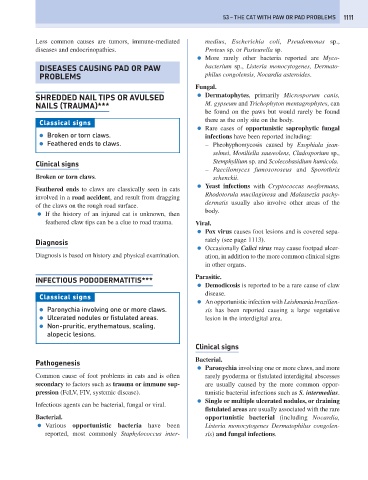Page 1119 - Problem-Based Feline Medicine
P. 1119
53 – THE CAT WITH PAW OR PAD PROBLEMS 1111
Less common causes are tumors, immune-mediated medius, Escherichia coli, Pseudomonas sp.,
diseases and endocrinopathies. Proteus sp. or Pasteurella sp.
● More rarely other bacteria reported are Myco-
DISEASES CAUSING PAD OR PAW bacterium sp., Listeria monocytogenes, Dermato-
PROBLEMS philus congolensis, Nocardia asteroides.
Fungal.
SHREDDED NAIL TIPS OR AVULSED ● Dermatophytes, primarily Microsporum canis,
NAILS (TRAUMA)*** M. gypseum and Trichophyton mentagrophytes, can
be found on the paws but would rarely be found
there as the only site on the body.
Classical signs
● Rare cases of opportunistic saprophytic fungal
● Broken or torn claws. infections have been reported including:
● Feathered ends to claws. – Pheohyphomycosis caused by Exophiala jean-
selmei, Moniliella sauveolens, Cladosporium sp.,
Clinical signs Stemphyllium sp. and Scolecobasidium humicola.
– Paecilomyces fumosoroseus and Sporothrix
Broken or torn claws. schenckii.
● Yeast infections with Cryptococcus neoformans,
Feathered ends to claws are classically seen in cats
Rhodotorula mucilaginosa and Malassezia pachy-
involved in a road accident, and result from dragging
dermatis usually also involve other areas of the
of the claws on the rough road surface.
body.
● If the history of an injured cat is unknown, then
feathered claw tips can be a clue to road trauma. Viral.
● Pox virus causes foot lesions and is covered sepa-
Diagnosis rately (see page 1113).
● Occasionally Calici virus may cause footpad ulcer-
Diagnosis is based on history and physical examination. ation, in addition to the more common clinical signs
in other organs.
Parasitic.
INFECTIOUS PODODERMATITIS***
● Demodicosis is reported to be a rare cause of claw
disease.
Classical signs
● An opportunistic infection with Leishmania brazilien-
● Paronychia involving one or more claws. sis has been reported causing a large vegetative
● Ulcerated nodules or fistulated areas. lesion in the interdigital area.
● Non-pruritic, erythematous, scaling,
alopecic lesions.
Clinical signs
Bacterial.
Pathogenesis
● Paronychia involving one or more claws, and more
Common cause of foot problems in cats and is often rarely pyoderma or fistulated interdigital abscesses
secondary to factors such as trauma or immune sup- are usually caused by the more common oppor-
pression (FeLV, FIV, systemic disease). tunistic bacterial infections such as S. intermedius.
● Single or multiple ulcerated nodules, or draining
Infectious agents can be bacterial, fungal or viral.
fistulated areas are usually associated with the rare
Bacterial. opportunistic bacterial (including Nocardia,
● Various opportunistic bacteria have been Listeria monocytogenes Dermatophilus congolen-
reported, most commonly Staphylococcus inter- sis) and fungal infections.

